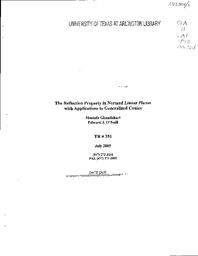
ATTENTION: The works hosted here are being migrated to a new repository that will consolidate resources, improve discoverability, and better show UTA's research impact on the global community. We will update authors as the migration progresses. Please see MavMatrix for more information.
Show simple item record
| dc.contributor.author | O'Neill, Edward J. | en |
| dc.contributor.author | Ghandehari, Mostafa | en |
| dc.date.accessioned | 2010-06-09T16:24:30Z | en |
| dc.date.available | 2010-06-09T16:24:30Z | en |
| dc.date.issued | 2005-07 | en |
| dc.identifier.uri | http://hdl.handle.net/10106/2476 | en |
| dc.description.abstract | **Please note that the full text is embargoed** ABSTRACT: The ancient Greek mathematician Heron was the first to solve the problem of finding the shortest path from point A to point B on one side of the line L, subject to the condition that the path goes from A to L and then to B (figure 1).
Figure 1.
His solution involved going from A to point R on L and then to B such that the line segments AR and BR make equal angles with L. This is exactly the path a light ray from A to B if L were a mirror. Heron included this proposition in his book Catoptrica, theory of mirrors. See Kline [5], p.168.
We use the method of Lagrange multipliers to extend Heron's problem from the Euclidean plane to real normed linear planes where the unit circles of the norm are strictly convex and are continuously differentiable. We also generalize familiar results from Euclidean geometry on the reflection properties of conics. In this introductory section we briefly review some results from Euclidean geometry and some basic properties of a norm which we will use in the following sections. | en |
| dc.language.iso | en_US | en |
| dc.publisher | University of Texas at Arlington | en |
| dc.relation.ispartofseries | Technical Report;351 | en |
| dc.subject | Euclidean geometry | en |
| dc.subject | Reflection properties of conics | en |
| dc.subject | Heron's problem | en |
| dc.subject.lcsh | Mathematics Research | en |
| dc.title | The Reflection Property in Normed Linear Planes with Applications to Generalized Conics | en |
| dc.type | Technical Report | en |
| dc.publisher.department | Department of Mathematics | en |
Files in this item
- Name:
- MathTechReport351.pdf
- Size:
- 515.3Kb
- Format:
- PDF
- Description:
- PDF
This item appears in the following Collection(s)
Show simple item record


